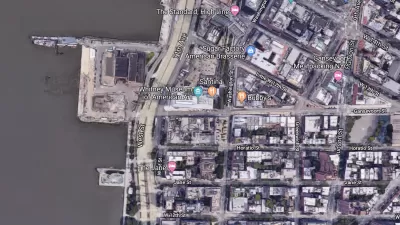With skyrocketing maintenance and repair costs gobbling up the Hudson River Park Trust's reserve fund, the HRPT has been pushing to change the park's enabling legislation to allow a wider variety of development types.
Alex Ulam reports on the status of a controversial proposal sent to Albany by the HRPT, the quasi-governmental agency that runs the park running along Manhattan's west side, "seeking to change the Hudson River
Park Act to remove some of the development restrictions, most notably
the one against residential development."
According to Ulam, that proposal, which faced opposition from community activists and legislators, has, "failed to get traction in Albany, leaving a big question mark over the future of one of the city's most significant parks."
With Pier 40 facing an estimated $120 million in necessary repairs, State Assemblymember Richard Gottfried, who introduced the bill to change the Hudson River Park Act, supported allowing residential uses in select areas of the park because, "housing has about the lowest traffic impact with the highest level of reliable revenue."
Critics, including State Assemblymember Deborah Glick, argue that, "The Trust is misrepresenting the degree of the crisis. The immediate
needs of Pier 40 and Pier 54 are not beyond the ability of the city and
state to address."
HRPT president Madelyn Wils contends that, "with the current rate of capital maintenance costs, HRPT will run out of money by the end of 2015."
FULL STORY: Pier Pressure

Maui's Vacation Rental Debate Turns Ugly
Verbal attacks, misinformation campaigns and fistfights plague a high-stakes debate to convert thousands of vacation rentals into long-term housing.

Planetizen Federal Action Tracker
A weekly monitor of how Trump’s orders and actions are impacting planners and planning in America.

San Francisco Suspends Traffic Calming Amidst Record Deaths
Citing “a challenging fiscal landscape,” the city will cease the program on the heels of 42 traffic deaths, including 24 pedestrians.

Defunct Pittsburgh Power Plant to Become Residential Tower
A decommissioned steam heat plant will be redeveloped into almost 100 affordable housing units.

Trump Prompts Restructuring of Transportation Research Board in “Unprecedented Overreach”
The TRB has eliminated more than half of its committees including those focused on climate, equity, and cities.

Amtrak Rolls Out New Orleans to Alabama “Mardi Gras” Train
The new service will operate morning and evening departures between Mobile and New Orleans.
Urban Design for Planners 1: Software Tools
This six-course series explores essential urban design concepts using open source software and equips planners with the tools they need to participate fully in the urban design process.
Planning for Universal Design
Learn the tools for implementing Universal Design in planning regulations.
Heyer Gruel & Associates PA
JM Goldson LLC
Custer County Colorado
City of Camden Redevelopment Agency
City of Astoria
Transportation Research & Education Center (TREC) at Portland State University
Jefferson Parish Government
Camden Redevelopment Agency
City of Claremont



























